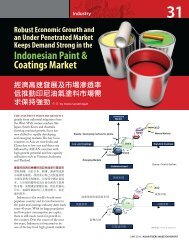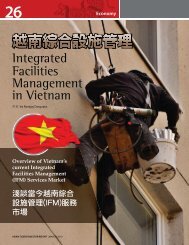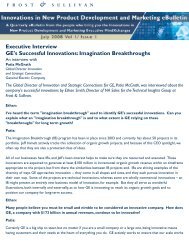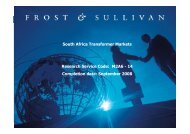Beyond the Bottom Line - Growth Consulting - Frost & Sullivan
Beyond the Bottom Line - Growth Consulting - Frost & Sullivan
Beyond the Bottom Line - Growth Consulting - Frost & Sullivan
Create successful ePaper yourself
Turn your PDF publications into a flip-book with our unique Google optimized e-Paper software.
eal impact on <strong>the</strong> environment. Recent work by Stanford University, <strong>the</strong> Uptime Institute, and AMD suggests that<br />
data centers contribute CO2 emissions in <strong>the</strong> same range as <strong>the</strong> airline industry, steel manufacturing, and ship building.<br />
This work also suggests that <strong>the</strong> cumulative impact of data centers contributes more CO2 to <strong>the</strong> atmosphere than<br />
does <strong>the</strong> country of Argentina or <strong>the</strong> Ne<strong>the</strong>rlands. Similarly, operating its network is <strong>the</strong> single largest source of<br />
power consumption for a typical telecom service provider. Therefore, eco-sustainability absolutely has a place in <strong>the</strong><br />
telecommunications industry.<br />
<strong>Frost</strong> & <strong>Sullivan</strong> has been covering eco-sustainability in <strong>the</strong> telecommunications industry since 2006. In that time, our<br />
work has uncovered a strong, but largely hidden trend of telecommunications service providers creating and following<br />
eco-sustainability strategies. Telecom companies tend to pursue eco-sustainability in three ways.<br />
Compliance to regulations or o<strong>the</strong>r mandated criteria.<br />
Eco-sustainability is pursued through adherence to defined limits and processes, which attempt to control<br />
consumption of non-renewable resources and curb <strong>the</strong> amount of pollution that needs to be absorbed by <strong>the</strong><br />
ecosystem. This is <strong>the</strong> most basic level of eco-sustainability strategy. Examples of regulations that directly impact<br />
telecom service providers include California’s 2006 Greenhouse Gas Bill and <strong>the</strong> mandate in China’s National Eleventh<br />
Five-Year Plan to lower power consumption by 20 percent per GDP unit. Telecom service providers can also set <strong>the</strong>ir<br />
own limits, such as BT’s goal to reduce CO2 emissions 80 percent from 1996 levels by 2016. Thus a compliance<br />
strategy engenders eco-sustainability by discouraging or slowing <strong>the</strong> impacts of unsustainable business practices.<br />
Commitment to sustainability through eco-efficiency.<br />
Here, eco-sustainability is pursued by using more resource efficient technologies to lower environmental impacts. This<br />
approach is often built on compliance actions, but adds a layer of pro-activity directed at lowering costs (saving on<br />
OPEX). Eco-sustainability is achieved through eco-efficiency, and collateral benefits are accrued, such as lower CO2<br />
emissions and recycling end-of-life network equipment. Higher CAPEX costs for renewable energy powered<br />
infrastructure are more than offset by <strong>the</strong> bottom line savings through <strong>the</strong> use of “free” energy. Under a commitment<br />
eco-sustainability strategy, Verizon has shown a savings in CO2 emissions with a trend of lower annual Carbon<br />
Intensity readings, defined as a ratio of metric tons of CO2 emitted per $1 million in revenue. As well, TELUS has<br />
demonstrated that from 2004 through 2007, its eco-efficiency -- <strong>the</strong> ratio of energy consumed to top-line revenues --<br />
has steadily improved. This is an important check on telecommunications eco-sustainability strategies because it<br />
shows that following such a strategy does not negatively impact overall revenue generation. Thus, a commitment<br />
strategy brings about sustainability discouraging unsustainable business practices and translates sustainable ones into<br />
bottom line savings.<br />
Command of eco-sustainability to drive top-line revenues.<br />
A command strategy goes one step fur<strong>the</strong>r than commitment because it uses eco-sustainability to drive new business<br />
and revenue streams. Building on compliance and commitment actions, telecom operators create new services that<br />
meet <strong>the</strong>ir own customers’ needs for sustainability solutions. Telecom Italia, in partnership with <strong>the</strong> Roman city<br />
government, has developed a service using cell phones that enables drivers to find <strong>the</strong> most direct route to available<br />
parking. This reduces gasoline costs for drivers, CO2 emissions in Rome, and can be a revenue generating service for














